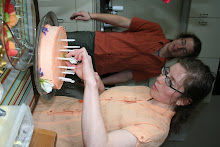
I have fond memories of sitting on the granite steps of my grandparents' house with a hammer and a basket of butternuts, carefully cracking the shells and extracting the tasty nutmeats. I do not remember any rhapsodizing that might have been going on amongst the adults, if any, but I vaguely recall a small expedition during which we had gathered the nuts from a stand of trees on the other side of town with permission of the owner. I imagine now that the owner was a friend or patient of my grandfather, the town doctor and quietly dedicated forager. The husks of these nuts, initially green and sticky, were decomposing, oxidizing brown and slightly slimy. We'd crack open the shell with the hammer and pick out the meat. Our fingers would be stained with the tannins for days, and aromatic....
I remember the flavor of these raw butternuts being sweet and so wonderful that to this day, anytime I find a green-husked windfall under a walnut-looking tree (and I keep my eye out for such things) I usually pause to find a stone or lump of asphalt with which to smash it then and there, to see if it possesses that same fine flavor. Any walnut species is fairly tasty, in my experience, but so far, I have not found one quite as nice as the butternut, which has led me to understand that this nut is rare. I believe that my grandfather was quite a fan of the species, and had propagated trees in his neighborhood (and had given one to my parents, who planted it near our compost pile, where I believe it still stands), but none ever yielded fruit. Having little background in botany I can't be sure of why this is, but I suspect it has to do with fertility and flowers, and lacking a second tree to germinate the first, or something....
Today, I know Butternut to be a valuable lumber, and my father is using quite a bit of it in his fine work. But where are the nuts? Not in the market, as far as I'm aware. I've found this factsheet from the national forest service which describes the fungus that has claimed many trees and made cultivation difficult. They are, as with the Hutterite beans of my previous post, in Slow's Arc of Taste.
